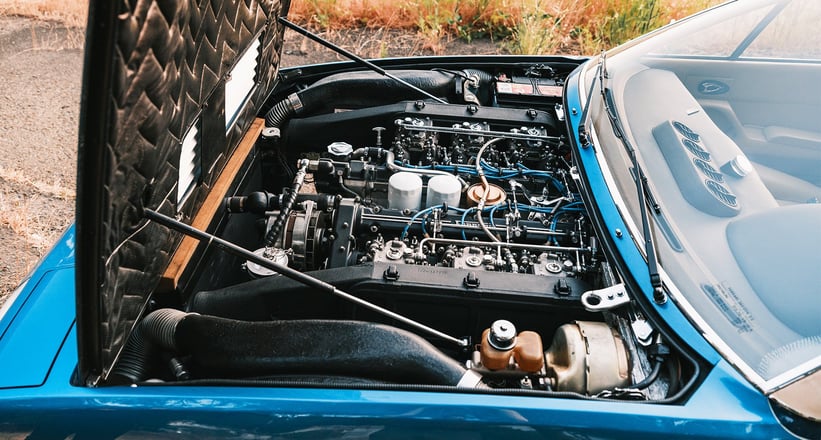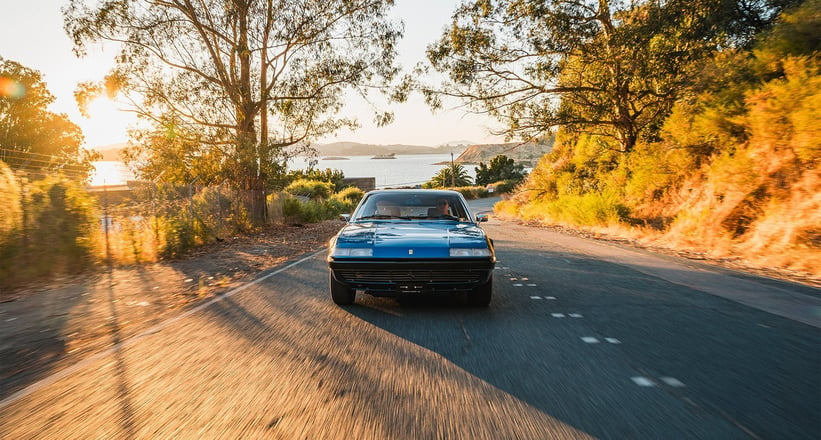


Ferrari caused quite a stir with the launch of its ‘FF’ grand tourer back in 2011 but, while it might have been the marque’s first factory-built car in the ‘estate’ format, it certainly wasn’t the first such prancing horse to hit the road.
And if you’re heading to Monterey Car Week and want to see the proof, look out for Swiss specialist car dealer Andreas Wuest who will be smoking around the peninsula in this unique and strangely cool Ferrari station wagon that was converted from a 365 GT4 almost 50 years ago. Once its cruising is complete, the car will be available via OTS and Co.


But even then, it wasn’t the first wagon to have been based on one of the Modenese marque’s grand tourers. Way back in 1967, U.S. Ferrari importer Luigi Chinetti commissioned coach builder Vignale to create a shooting brake body for a 330 GT , a car that subsequently ended up in the renowned Petersen Museum before being snapped-up by British musician and Jamiroquai front man Jay Kay.

In 1972, Chinetti also commissioned the conversion of a 365 GTB/4 Daytona into a high-speed station wagon on behalf of Florida real estate mogul Bob Gittleman, tasking British firm Panther Westwinds with fabricating the one-off bodywork. Panther was the Surrey-based builder of niche sports cars set-up by designer Robert Jankel that found success with its Morgan-like Lima and Kallista two-seaters. The firm also developed some rather more far-out creations, such as the six-wheeled, 8.2 litre Cadillac-engined ‘Panther Six’ convertible of 1977 and the luxurious de Ville, the shameless flamboyance of which attracted buyers such as rock star Elton John and actor Oliver Reed.



And it was probably Panther’s willingness to take-on unusual projects - combined with its reputation for high quality work - that led a go-getting Swiss car dealer called Willy Felber to turn to the manufacturer in 1976 after receiving a potentially lucrative request from an Arab sheikh to supply a Ferrari that was ‘something different’.
The imaginative Felber had been obsessed with cars since a young age and began sketching-out his own designs as a teenager during the 1940s, raising parental hopes that he might follow his father into the engineering business (among other major projects, he had designed and built the six-kilometre Great St Bernard Tunnel linking Switzerland with northwest Italy).


But after completing his studies at the University of Lausanne, Felber junior felt compelled to answer the siren call of the exotic car world. Having cut his teeth as a salesman, Felber subsequently opened a parts store before setting-up “High Performance” garage near Morges, which he developed into an official dealership for both Ferrari and Rolls-Royce.
Felber’s endearing personality and smart business mind soon enabled him to become a supplier of cars to major celebrities of the day, such as Charlie Chaplin and Johnny Halliday, as well as many of the greats of Formula One, including Mario Andretti, James Hunt and Emerson Fittipaldi.

But it was the fresh oil money pouring into Europe from the Middle East that really enabled Felber to both indulge his long-standing dream of creating unique and far-out cars and to boost his already burgeoning bank balance. Combined with an unrivalled ‘little black book’ of contacts in the motor trade and in the car design world, that made Felber the go-to man for people such as the sheikh who fancied this Ferrari shooting brake.
In order to facilitate the project, Felber bought the car from SAVAF in 1975 shortly after it was displayed on the Ferrari stand at the Geneva Motor Show, and then sold it to one of his clients. In 1976, he then bought it back from that client after receiving the Middle Eastern commission and sent it to Panther. It had seen virtually no use and was therefore ideal as the basis from which to create what would be an effectively brand new ‘special’. Felber called upon none other than Giovanni Michelotti to pen the bodywork, immediately dispatching the car to the UK so that Panther Westwinds could get on with turning the celebrated designer’s vision into rolling reality as soon as possible. Panther’s highly skilled fabricators completed the conversion to its usual factory standard in a matter of weeks – but not quickly enough to pre-empt Felber’s client backing-out of the deal and, therefore, leaving the unique car without a home.


Finished in ‘Blue Ribot’ with a white vinyl roof and equipped with a fridge and television set, the ‘Felber Croisette SW’ was certainly ‘something different', but with the aftermath of the middle eastern oil crisis still killing sales of big-engined, gas-guzzling cars, Felber finally found a buyer in the form of Bern garage manager Albrecht Guggisberg.
He, in turn, sold it to a Zurich-based Ferrari fan for a modest 45,000 Swiss francs - and it remained in his hands until being advertised for 300,000 Swiss francs in 1990. The most recent owner, garage proprietor and Ferrari collector Roger Imboden, acquired the Felber Croisette to complete his trio of Felber Ferraris – the others being the spectacular 365GTC-based ‘beach car’ and the 166 Spider Corsa-inspired FF.

Until this month the car had remained in Switzerland ever since its original importation from Italy (save for that brief trip to Panther Westwinds) – meaning this year’s Monterey Car Week will represent its first exposure to the wider world. Still wearing its Blue Ribot paintwork and white roof, it is to almost the exact specification today as it was when it left Panther Westwinds all those decades ago, the only difference being that the fridge is missing.
Other than that, it continues to sport its twin, roof-mounted antennae, ‘Pelle Beige’ Connolly hide and the decidedly of-the-era cathode ray television set that nestles between the front seats. With documentary evidence suggesting that the sub-80,000 km reading on the odometer is correct, this unique Ferrari is up, running and on the button and - once Andreas Wüest has wowed the crowds with it at Monterey - will be available to see (and to buy) at the East Bay, San Francisco premises of OTS and Co. Well, you have always said you’d love something different, haven’t you?
Photos by Kevin Arechiga












































